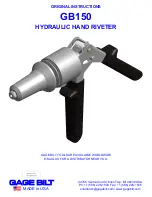
6
Eastwood Technical Assistance: 800.343.9353 >> [email protected]
FIG. 12
FIG. 12
FIG. 13
FIG. 13
FIG. 14
FIG. 14
MINI ENGLISH WHEEL USAGE
ANVIL SELECTION
• Each anvil has a different profile intended for creating a variety of contours in
metal sheet. Choose the anvil with the profile that most closely matches the
panel curvature to be achieved.
• The included Anvil set is comprised of 1/2”, 1”, 2”, and 3” radiused Anvils
[K, L, M & N]
. Optionally, a 5” Radius Anvil (#54836) is available for very
gentle curves or stretching and a Flat Anvil (#54831) for stretching metal can
be purchased separately.
• Illustrated are the included Anvil Radii and the contours they can be expected to
product
(FIG 12)
.
PANEL FORMING
English Wheeling is an age-old metal-working skill that many metal workers consider
an art. Some amazing forms can be created in a piece of metal when in the hands of an
experienced wheeler. Keep in mind that there are differing methods of operation which
vary among professional wheelers. None are absolutely fixed in stone as the “correct”
way and none are wrong. It is simply a matter of choosing which method you find most
comfortable as it is the results that matter most. The best method for learning is to ob-
tain several metal-working books and videos containing material on English Wheeling by
different well-known metal workers then determine which methods appeal most to you.
The #1 most important rule in becoming an expert in the time-honored art of English
Wheeling is Practice, Practice, Practice. As with any professional metal working equip-
ment, the English Wheel requires a learning curve to be able to achieve desired results
that once achieved, prove to be highly satisfying.
The following are several basic elements crucial to English Wheeling that are:
• Obtain a stack of 8” x 10”, 20-gauge aluminum and steel panels to use as
practice pieces.
• Leaving a gap equal to the thickness of the workpiece between the Wheel and
Anvil, place a practice piece of aluminum between them then raise the Jackscrew
until the anvil just contacts the metal and the metal contacts the Wheel, allowing
easy rolling between the Anvil and Wheel (Fig 13).
• Keep in mind that the metal forming is done by passing the metal over the anvil
while pulling it down and shaping it. The Wheel functions as a guide.
• It is normal to constantly adjust the anvil tension as you work. The goal is to have
it “not too tight yet not too loose.”
• Grasp the edges of the metal and continue to exert a gentle but firm downward
force while rolling it. With repeated rolling, a curvature will begin to appear in the
metal
(FIG 14)
.
DO NOT overtighten the Jackscrew which would press the
Anvil against the Wheel!
Overtightening will quickly crease and harden the metal, create
unnecessary effort, and will damage the surface of the Anvil.
When forming a panel, only minimal pressure is required to hold
the metal in place.


























